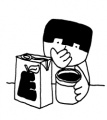Hírek téma szerint
 A Ne várásolj semmit nemzetközi akciónapon a Humusz és a ZöFi aktivistái közvetlenül a fogyasztókkal próbáltak szót érteni. A Nyugati téri Kaiser’s-bõl kijövõ vásárlóktól azt szerették volna megtudni, hogy mi motiválja élelmiszer vásárlásaikat – a szemükkel vásárolnak-e vagy az eszükkel? Figyelik-e vajon az élelmiszerek összetételét és ha igen, mennyire befolyásolja õket a csomagoláson feltûntett adalékanyagok ( E-számok)? Tudják-e vajon mit (v)esznek? [Kalas György cikke a greenfo.hu-n]
A Ne várásolj semmit nemzetközi akciónapon a Humusz és a ZöFi aktivistái közvetlenül a fogyasztókkal próbáltak szót érteni. A Nyugati téri Kaiser’s-bõl kijövõ vásárlóktól azt szerették volna megtudni, hogy mi motiválja élelmiszer vásárlásaikat – a szemükkel vásárolnak-e vagy az eszükkel? Figyelik-e vajon az élelmiszerek összetételét és ha igen, mennyire befolyásolja õket a csomagoláson feltûntett adalékanyagok ( E-számok)? Tudják-e vajon mit (v)esznek? [Kalas György cikke a greenfo.hu-n] A Ne Vásárolj Semmit Napot idén november 24-én, pénteken ünneplik. Mi megelõztük korunkat. A HuMuSz és a Zöld Fiatalok csütörtök délelõtt rendezett utcai demonstrációt a Nyugati téren. Idén arra koncentráltunk, hogy mennyi fölösleges, sõt ártalmas ételt akarnak megetetni velünk.
A Ne Vásárolj Semmit Napot idén november 24-én, pénteken ünneplik. Mi megelõztük korunkat. A HuMuSz és a Zöld Fiatalok csütörtök délelõtt rendezett utcai demonstrációt a Nyugati téren. Idén arra koncentráltunk, hogy mennyi fölösleges, sõt ártalmas ételt akarnak megetetni velünk.
 A HuMuSz összefoglalót készített az önkormányzatok számára a szemétdíj kivetésének szabályozásáról, a jelenlegi gyakorlat ellentmondásairól, a felmerült alkotmányossági aggályokról és arról, hogy miként lehetne a szemétdíjat úgy megreformálni, hogy ösztönözze az embereket a megelõzésre, a szelektálásra és a komposztálásra.
A HuMuSz összefoglalót készített az önkormányzatok számára a szemétdíj kivetésének szabályozásáról, a jelenlegi gyakorlat ellentmondásairól, a felmerült alkotmányossági aggályokról és arról, hogy miként lehetne a szemétdíjat úgy megreformálni, hogy ösztönözze az embereket a megelõzésre, a szelektálásra és a komposztálásra. A Hulladék Munkaszövetség és a Zöld Fiatalok sajtóanyaga
A Hulladék Munkaszövetség és a Zöld Fiatalok sajtóanyaga
A Ne Vásárolj Semmit Napnak a világban már 14, Magyarországon 7 éves hagyománya van. Idén is több szervezet, több rendezvényen hívja fel a figyelmet a túlzott fogyasztás környezeti és etikai vonatkozásaira. A HuMuSz és a ZÖFI ebbõl az alkalomból látványos utcai demonstráció keretén belül az élelmiszerek adalékanyagainak lehetséges veszélyeire figyelmeztet. Nemrég jelent meg Kalas György: Nyisd ki a szemed, csukd be a szád c. kiadványának átdolgozott kiadása, amely a német ÖKO-TEST Verlag szakmai anyagaira épül.
Ön szeretné hogy térdelõ nõk képéivel adjanak el dezodorokat? Ne hagyjuk,
hogy emberi jogokat sértõ reklámokkal etessenek!!!! A fogyasztóknak van
véleményük!
 A The New York Inquirer összeállította a világ hét szemétcsodáját, a cikk Aaron Labaree tollából származik. Riasztó tények irdatlan tömegû hulladékról a Csendes-óceánról, New Yorkból, Indiából, a Fülöp-szigetekrõl, az USA Nevada államából és Kínából.
A The New York Inquirer összeállította a világ hét szemétcsodáját, a cikk Aaron Labaree tollából származik. Riasztó tények irdatlan tömegû hulladékról a Csendes-óceánról, New Yorkból, Indiából, a Fülöp-szigetekrõl, az USA Nevada államából és Kínából.
 |
Elhárult a törvényi akadály a királyszentistváni hulladéklerakó építése elõl. A parlamentben hétfõn megszavazták ugyanis az Országos Területrendezési Tervrõl és a Balatoni Területrendezési Szabályzatról szóló törvények módosítását. Az Országgyûlés 316 igen, 1 nem és 1 tartózkodás mellett fogadta el a javaslatot. [uno.hu]
Három egyetemista bontja szét a használt elektromos készülékeket abban a gyõri laborban, ahol az úgynevezett e-hulladékok újrafelhasználási lehetõségeit tanulmányozzák. A számítógépeket, nyomtatókat, fénymásolókat és televíziókat apró darabokra szedik,alkotóelemeiket beazonosítják és azt is megállapítják, hogy mennyi veszélyes anyag van bennük. [uno.hu]
 A Hulladék Munkaszövetség várja olyan iskolák, óvodák, egyéb intézmények jelentkezését, melyek gyakorlati tapasztalatokat szereztek lombkomposztálás terén – azaz udvarukban, parkjukban maguk komposztálják az õszi avart - és szívesen megosztanák véleményeiket, sikereiket, eredményeiket más intézményekkel is.
A Hulladék Munkaszövetség várja olyan iskolák, óvodák, egyéb intézmények jelentkezését, melyek gyakorlati tapasztalatokat szereztek lombkomposztálás terén – azaz udvarukban, parkjukban maguk komposztálják az õszi avart - és szívesen megosztanák véleményeiket, sikereiket, eredményeiket más intézményekkel is.  Mire jó a hulladék? A Hulladék Munkaszövetség (HuMuSz) kézműves foglalkozásai iskolás csoportoknak a 2006/2007-es tanévben.
Mire jó a hulladék? A Hulladék Munkaszövetség (HuMuSz) kézműves foglalkozásai iskolás csoportoknak a 2006/2007-es tanévben.
A 90 perces foglalkozások alkalmával a gyerekek felfedezhetik, hogy mi mindenre jók még a szemétbe szánt dolgok. Ajándékokat, használati tárgyakat készíthetnek feleslegessé vált anyagokból.
 A földigiliszta nagy segítséget nyújt a komposztáló kertbarátok számára. Íme egy cikk, melybõl többet is megtudhatunk errõl a hasznos kis lényrõl. A Szabad Föld írása.
A földigiliszta nagy segítséget nyújt a komposztáló kertbarátok számára. Íme egy cikk, melybõl többet is megtudhatunk errõl a hasznos kis lényrõl. A Szabad Föld írása. 